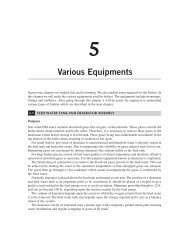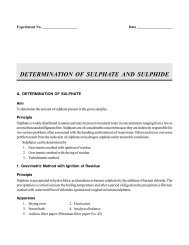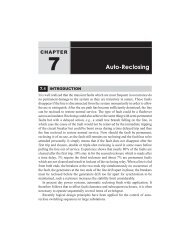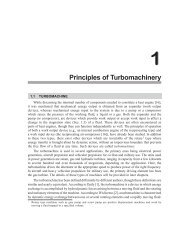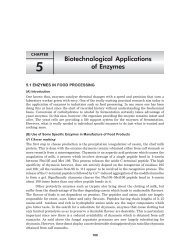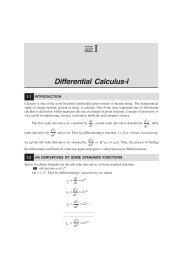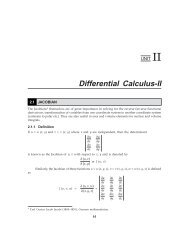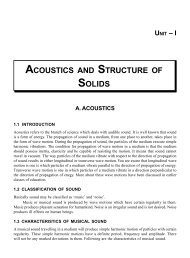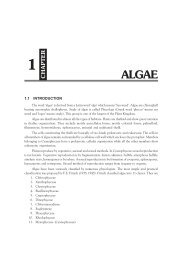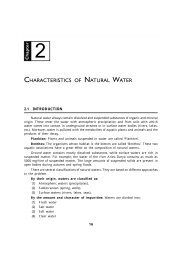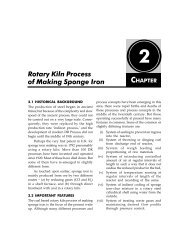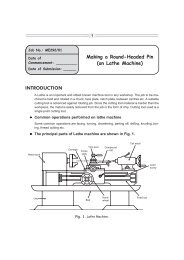1.2 type of bonds - New Age International
1.2 type of bonds - New Age International
1.2 type of bonds - New Age International
Create successful ePaper yourself
Turn your PDF publications into a flip-book with our unique Google optimized e-Paper software.
1.1 INTRODUCTION<br />
1<br />
Chemical Bonding<br />
Atoms combine to form molecules. The combining power <strong>of</strong> atoms to form molecules is called<br />
valency (Latin word valentia; meaning strength). Valency <strong>of</strong> an atom indicates the number<br />
<strong>of</strong> atoms <strong>of</strong> hydrogen which combine with one atom <strong>of</strong> an element. This definition <strong>of</strong> valency<br />
has, however, failed in case <strong>of</strong> carbon, as the valency in the compounds C 2H 2, C 2H 4, C 2H 6<br />
and CH 4 varies from 1 to 4.<br />
With the advancement <strong>of</strong> knowledge about atomic structure, it was realized that electrons<br />
in atoms were primarily involved in chemical combinations. According to the ‘Lewis octet<br />
rule’, atoms <strong>of</strong> all elements have a tendency to acquire an electronic configuration similar to<br />
that <strong>of</strong> inert gases because it represents the most stable electronic configuration. All atoms<br />
having unstable or incomplete outer shell have a tendency to gain or lose electrons so as to<br />
acquire an electronic configuration <strong>of</strong> the nearest inert gas in the Periodic Table. It is this<br />
tendency <strong>of</strong> atoms to complete and hence stabilize their outermost orbit <strong>of</strong> electrons which is<br />
mainly responsible for chemical combination between the atoms.<br />
Thus, according to ‘electronic theory <strong>of</strong> valency’ ‘a chemical bond is formed as a result<br />
<strong>of</strong> electronic interactions. It may, however be noted that a molecule is formed only when<br />
electrons <strong>of</strong> the constituent atoms interact in such a way that the potential energy is<br />
lowered. Greater the lowering <strong>of</strong> potential energy, greater is the strength <strong>of</strong> the bond.<br />
Subsequently, the ‘wave mechanical theory’ was developed which gave logical understanding<br />
<strong>of</strong> bonding between atoms. On the basis <strong>of</strong> wave mechanical theory, it is also<br />
possible to make fruitful predictions regarding the geometrical structure <strong>of</strong> molecules.<br />
<strong>1.2</strong> TYPE OF BONDS<br />
According to the electronic theory <strong>of</strong> valency the interaction <strong>of</strong> extranuclear electrons leads to<br />
the formation <strong>of</strong> following <strong>type</strong> <strong>of</strong> <strong>bonds</strong>:<br />
(i) Electrovalent or ionic bond<br />
(ii) Covalent bond<br />
(iii) Coordinate bond.<br />
There are mainly three ways by which the atoms may obtain a stable electronic configuration,<br />
namely, by gaining, losing or sharing <strong>of</strong> electrons. We divide all the known elements<br />
on electronegativity scale into:<br />
(a) electropositive elements, whose atoms give up one or more electrons readily<br />
(b) electronegative elements, whose atoms take up electrons<br />
(c) elements whose atoms neither lose nor gain electrons.<br />
1
2 Fundamentals <strong>of</strong> Engineering Chemistry<br />
Thus, the following three <strong>type</strong>s <strong>of</strong> <strong>bonds</strong> are possible by the different <strong>type</strong>s <strong>of</strong> combinations<br />
<strong>of</strong> the three <strong>type</strong>s <strong>of</strong> elements:<br />
(i) Electropositive elements + Electronegative elements Æ Ionic bond<br />
(ii) Electronegative elements + Electronegative elements Æ Covalent bond<br />
(iii) Electropositive elements + Electropositive elements Æ Coordinate bond.<br />
<strong>1.2</strong>.1 Electrovalent or Ionic Bond<br />
The ionic bond is formed due to the “electrostatic attraction between stable ions formed by<br />
the complete transfer <strong>of</strong> electrons from one atom to another”, and the combining atoms<br />
acquire inert gas configuration. The atom which loses electrons acquires a positive charge,<br />
whereas the one which gains electrons becomes negatively charged. These charged atoms are<br />
called ions and held together by electrostatic attraction forces. Such a mode <strong>of</strong> combination <strong>of</strong><br />
atoms is called electrovalency and the bond formed between the atom is called electrovalent<br />
or Ionic bond. The compound thus formed is called an electrovalent or ionic compound.<br />
Atoms having a tendency to lose electrons are called electropositive whereas the atoms<br />
which gain electrons are called electronegative. The number <strong>of</strong> electrons gained or lost by an<br />
atom in order to acquire an inert gas configuration gives numerical value <strong>of</strong> the electrovalency<br />
<strong>of</strong> the atom.<br />
Let us consider the formation <strong>of</strong> sodium chloride (NaCl) as an example. The electronic<br />
arrangement <strong>of</strong> Na and Cl atoms are:<br />
Na (11) 2, 8, 1 (1s 2 , 2s 2 , 2p 6 , 3s 1 )<br />
Cl (17) 2, 8, 7, (1s2 , 2s2 , 2p6 , 3s2 , 3p5 )<br />
The electron from the outermost orbit <strong>of</strong> Na is completely transferred to the outermost<br />
orbit <strong>of</strong> Cl atom. As a result <strong>of</strong> this transfer, both atoms acquire inert gas structure. The Na<br />
becomes Na + (2, 8) and Cl become Cl – (2, 8, 8).<br />
They attain inert gas structure <strong>of</strong> neon and argon respectively. The two +ve and –ve ions<br />
are held together by electrostatic force <strong>of</strong> attraction acting between them. The formation <strong>of</strong><br />
NaCl is depicted below:<br />
Na ¥<br />
..<br />
+ .Cl: ..<br />
Æ [Na] +<br />
Cl :<br />
..<br />
× . ..<br />
(2, 8, 1) (2, 8, 7) (2, 8) (2, 8, 8)<br />
+ –<br />
Na Cl<br />
In the formation <strong>of</strong> BaCl 2 , two electrons from outermost shell <strong>of</strong> Ba are completely<br />
transferred to the outermost orbit <strong>of</strong> two chlorine atoms. By losing two electrons Ba becomes<br />
bivalent Ba 2+ ion having two positive charges. It combines with two chlorine ions formed from<br />
chlorine atoms by accepting one electron each.<br />
..<br />
:Cl. ..<br />
..<br />
..<br />
× . ×<br />
Ba . Cl:<br />
Æ [Ba] 2+<br />
L<br />
M<br />
NM<br />
..<br />
: Cl:<br />
.<br />
.<br />
: Cl .. :<br />
x<br />
x<br />
Other examples <strong>of</strong> ionic compounds are CaS, KCl, MgCl 2 , K 2 O etc.<br />
O<br />
P<br />
QP<br />
− 2
Chemical Bonding 3<br />
Electrovalent compounds exhibit following properties:<br />
(i) Electrovalent compounds are generally hard solids.<br />
(ii) They have high melting and boiling point.<br />
(iii) Electrovalent compounds are generally sparingly soluble in organic solvents.<br />
(iv) Electrovalent compounds in solid state are poor conductors <strong>of</strong> electricity. But when<br />
dissolved in solvents <strong>of</strong> relatively high dielectric constant, they exhibit a strong electrical<br />
conductivity. They also conduct electricity in the molten state.<br />
<strong>1.2</strong>.2 Covalent Bond<br />
Formation <strong>of</strong> molecules by the sharing <strong>of</strong> electrons between combining atoms is called<br />
covalency and the bond formed is called colvalent bond or covalent linkage. Compounds<br />
containing this <strong>type</strong> <strong>of</strong> linkage are called covalent compounds. In covalent bond formation<br />
the inert gas configuration <strong>of</strong> the two concerned atoms is achieved by sharing equal number<br />
<strong>of</strong> electrons.<br />
The sharing <strong>of</strong> electrons to form chemical bond between two atoms is described by showing<br />
pairs <strong>of</strong> electrons between the bonded atoms. If one pair <strong>of</strong> electrons is shared, the bond<br />
formed is called single bond, whereas sharing <strong>of</strong> two or three pairs <strong>of</strong> electrons leads to the<br />
formation <strong>of</strong> double or triple <strong>bonds</strong> respectively. Due to sharing <strong>of</strong> electrons, both the bonding<br />
atoms acquire inert gas configuration.<br />
Let us consider the formation <strong>of</strong> hydrogen molecule from two hydrogen atoms. Each hydrogen<br />
atom has only one electron and thus its configuration is unstable but when both the<br />
hydrogen atoms share their electrons to form a pair <strong>of</strong> electrons equally shared between the<br />
two atoms i.e., the pair <strong>of</strong> electrons becomes a common property <strong>of</strong> the two hydrogen atoms;<br />
the resulting molecule acquires He configuration.<br />
The covalent bond is represented by a dash (–).<br />
H 2 H . + xH Æ H x . H or H—H<br />
[1s 1 ] [1s 1 ] [1s 2 ]<br />
Similarly, the formation <strong>of</strong> CCl 4 and CH 4 takes place as below:<br />
..<br />
:Cl:<br />
:Cl . .. ..<br />
C .Cl:<br />
x<br />
.<br />
:Cl:<br />
x<br />
x.<br />
x<br />
.. ..<br />
..<br />
H<br />
H· C ·H<br />
x<br />
.<br />
H<br />
x<br />
x.<br />
x<br />
..<br />
:Cl:<br />
..<br />
..<br />
.<br />
.x<br />
.x<br />
:Cl: ..<br />
.x<br />
..<br />
..<br />
:Cl x C Cl:<br />
.<br />
H<br />
.x .x<br />
H x C H<br />
.x<br />
H<br />
or<br />
or<br />
Cl<br />
Cl—C—Cl<br />
Cl<br />
H<br />
H—C—H<br />
Some other examples <strong>of</strong> the formation <strong>of</strong> covalent compounds is shown below:<br />
(i) Single <strong>bonds</strong>:<br />
H2 H· + ·H ⎯⎯→ H—H<br />
.. ..<br />
Cl2 : Cl .. . . Cl:<br />
⎯⎯→ Cl—Cl<br />
..<br />
H
4 Fundamentals <strong>of</strong> Engineering Chemistry<br />
(ii) Double <strong>bonds</strong>:<br />
(iii) Triple <strong>bonds</strong>:<br />
O 2<br />
O .. .. : + :O ..<br />
.. O O<br />
.. ..<br />
CO2 O.. : x x<br />
x C x: O..<br />
O C O<br />
N 2 :NM + MN: N N<br />
CH 2 2 H · x CxxC x · H<br />
(acetylene)<br />
x x<br />
x x<br />
H—C C—H<br />
In covalent compounds the numerical value <strong>of</strong> covalency <strong>of</strong> any element in the molecule is<br />
the number <strong>of</strong> electron pairs shared between the atoms. Thus the valency <strong>of</strong> hydrogen in H2 is one, oxygen in O2 is two, nitrogen in N2 is three and carbon in CH4 is four.<br />
The covalent <strong>bonds</strong> are <strong>of</strong> two <strong>type</strong>s:<br />
(A) Polar covalent <strong>bonds</strong>,<br />
(B) Non-polar covalent <strong>bonds</strong>.<br />
(A) Polar Covalent Bonds<br />
When a bond is formed between unlike atoms, the bonding electrons will not be equally<br />
shared. The resulting bond is a polar covalent bond. e.g., formation <strong>of</strong> HCl.<br />
H x. ..<br />
+ –<br />
Cl: ..<br />
H—Cl<br />
The shared electrons will be shifted more towards the atom having higher electronegativity<br />
and this will result in the accumulation <strong>of</strong> a –ve charge on it. The other atom will carry an<br />
equivalent +ve charge. In the above example <strong>of</strong> HCl, the chlorine atom acquires small amount<br />
<strong>of</strong> –ve charge because <strong>of</strong> its higher electronegativity and hydrogen has an equivalent +ve<br />
charge. The d + and d – represents respectively the small +ve and –ve charge.<br />
(B) Non-polar Covalent Bonds<br />
When a bond is formed between atoms <strong>of</strong> the same element, the bonding electrons are<br />
equally shared on account <strong>of</strong> equal electronegativity <strong>of</strong> the atoms. The resulting bond is a<br />
non-polar covalent bond. In case <strong>of</strong> such a bond, the centre <strong>of</strong> +ve charge coincides with the<br />
centre <strong>of</strong> –ve charge in the molecule.<br />
For example, <strong>bonds</strong> involved in the formation <strong>of</strong> H2 , Cl2 , O2 , N2 etc. are non-polar <strong>bonds</strong>.<br />
H . . H H—H<br />
xx ..<br />
x C x . Cl:<br />
xx ..<br />
Cl—Cl<br />
Covalent compounds possess following general characteristics:<br />
(i) Colvalent compounds possess definite geometrical shapes. They exhibit isomerism because<br />
covalent <strong>bonds</strong> are rigid and possess directional characteristics.
Chemical Bonding 5<br />
(ii) Covalent compounds are mostly liquids and gases. The solid compounds are generally<br />
volatile.<br />
(iii) They are highly soluble in organic solvents but slightly soluble in water. Some compounds<br />
like HCl and NH3 readily dissolve in water because they react with water.<br />
HCl + H2Oææ Æ [H3O] + + Cl –<br />
NH3 + H2Oææ Æ [NH4] + + OH –<br />
(iv) The melting and boiling points <strong>of</strong> covalent compounds are relatively low because the<br />
forces involved in covalent compounds are less strong than those involved in electrovalent<br />
or ionic compounds.<br />
(v) These compounds do not contain ions. Therefore, when dissolved, they do not conduct<br />
electricity. They even do not conduct electricity in the molten state.<br />
Comparison <strong>of</strong> Electrovalent and Covalent Compounds<br />
The essential difference between electrovalent and covalent linkages is that in the former<br />
case complete transference <strong>of</strong> electrons between the atoms takes place whereas in the latter<br />
case there is no transfer <strong>of</strong> electrons between the bonding atoms but instead, there is sharing<br />
<strong>of</strong> electrons. Since no transfer <strong>of</strong> electrons is involved, colvalent compounds are non-ionic in<br />
nature.<br />
Sl. Electrovalent or Covalent Compounds<br />
No. Ionic Compounds<br />
1. This <strong>type</strong> <strong>of</strong> bond is frequently encountered This <strong>type</strong> <strong>of</strong> bond is frequently found in<br />
in inorganic compounds. organic compounds.<br />
2. Electrovalent compounds are soluble in Covalent compounds are soluble in organic<br />
water but insoluble in organic solvents solvents and insoluble in water.<br />
3. They possess high M.P. & B.P. They have low M.P. and B.P.<br />
4. Electrovalent compounds are not They are inflammable.<br />
inflammable.<br />
5. They do not possess any characteristic They usually possess a characteristic smell.<br />
smell.<br />
6. In electrovalent compounds reactions are In covalent compounds reactions are slow.<br />
rapid.<br />
<strong>1.2</strong>.3 Coordinate Bond<br />
When, an atom having a complete octet donates a pair <strong>of</strong> free valence electrons to another<br />
atom which is short <strong>of</strong> two electrons, the resulting bond is known as coordinate bond. Thus<br />
both the atoms acquire inert gas configurations.<br />
The atom which donates a pair <strong>of</strong> electrons is called ‘donor’ and the other atom which<br />
accepts the electrons is called ‘acceptor’. The coordinate bond is similar to covalent bond<br />
except that both the shared electrons are donated by one atom. The formation <strong>of</strong> covalent and<br />
coordinate bond is illustrated below:<br />
A . + . B ææÆ A : B or A—B (Normal covalency)<br />
A : + B A : B or AB (Coordinate valency)
6 Fundamentals <strong>of</strong> Engineering Chemistry<br />
When one atom furnishes both electrons for the formation <strong>of</strong> a covalent bond as described<br />
above, the process is called ‘coordination’.<br />
Since one atom donates an electron pair and the other accepts, the molecule acquires<br />
polarity. These <strong>bonds</strong>, therefore, are also known as ‘semi polar <strong>bonds</strong>’ or ‘dative bond’.<br />
The extent <strong>of</strong> polarity is larger than that <strong>of</strong> covalent <strong>bonds</strong> although less than electrovalent<br />
<strong>bonds</strong>. Coordinate bond is represented by the symbol (Æ).<br />
Formation <strong>of</strong> some coordinate compounds is illustrated below:<br />
+<br />
(i) Ammonium ion [NH4 ]<br />
− 3<br />
(ii) Phosphate ion [PO 4 ]<br />
(iii) Sulphate ion [SO 4 2– ]<br />
H H<br />
.<br />
x<br />
+<br />
. x<br />
x<br />
H x N x H or H N H<br />
x.<br />
H<br />
H<br />
P + 3e P<br />
–<br />
xx xx<br />
–3<br />
x x x<br />
x x x<br />
x<br />
x x<br />
: O:<br />
:<br />
: O x P<br />
:<br />
:<br />
x<br />
x x<br />
x x<br />
: O:<br />
:<br />
x<br />
x<br />
O:<br />
:<br />
:<br />
–3<br />
or<br />
O<br />
O P O<br />
O<br />
<br />
<br />
<br />
S + 2e S<br />
–<br />
x x<br />
x x –2<br />
x x x<br />
x x x<br />
x x<br />
x x<br />
: O:<br />
:<br />
: O x S<br />
:<br />
:<br />
(iv) Compounds <strong>of</strong> NH 3 + BCl 3<br />
H .<br />
x<br />
x<br />
x x<br />
x x<br />
: O:<br />
:<br />
x<br />
x<br />
H<br />
. : Cl:<br />
x<br />
x<br />
:<br />
:<br />
N x B<br />
x<br />
.<br />
H<br />
:<br />
: Cl:<br />
:<br />
O:<br />
:<br />
:<br />
:<br />
: :<br />
Cl:<br />
or<br />
or<br />
O<br />
O S O<br />
O<br />
<br />
<br />
<br />
–2<br />
–3<br />
H Cl<br />
H Cl<br />
+<br />
H—NB—Cl
Chemical Bonding 7<br />
Following are the main characteristics <strong>of</strong> coordination compounds:<br />
(i) Coordinate compounds, like covalent compounds, exhibit space isomerism. This is due to<br />
directional characteristics possessed by coordinate linkage.<br />
(ii) The B.P. and M.P. <strong>of</strong> these compounds have intermediate value between electrovalent<br />
and covalent compounds.<br />
(iii) They are only slightly soluble in water and most <strong>of</strong> them are soluble in organic solvents.<br />
(A) Exceptions to the Octet Rule<br />
There are certain stable compounds where the octet rule is not obeyed, that is, their valence<br />
shells contain more or less than 8 electrons. The compounds containing less than 8 electrons<br />
in the valence shells are called electron deficient compounds such as B2F6 , Al2Cl6 etc. On<br />
the other hand, the compounds containing more than 8 electrons in the valence shells may be<br />
called electron surplus compounds e.g., PCl5, SF6, OsF8 etc.<br />
In an electron deficient compound such as B2F6, the available electrons are insufficient<br />
for sharing between the two boron atoms and the six fluorine atoms. Each boron atom has<br />
three electrons so that the two boron atoms have six electrons which are just sufficient for<br />
binding the three fluorine atoms. It has been suggested that boron atoms in B2F6 complete<br />
their octet by accepting a pair <strong>of</strong> electrons from fluorine atoms. The existence <strong>of</strong> Al2Cl6 can<br />
also be explained on the same basis. The structure <strong>of</strong> B2F6 and Al2Cl6 are given below:<br />
F F F<br />
: F x. B<br />
. x<br />
: F :<br />
x.<br />
F : or F—B—F<br />
F<br />
F<br />
B<br />
F<br />
B<br />
F<br />
:<br />
:<br />
: Clx.<br />
:<br />
:<br />
:<br />
Al<br />
. x<br />
: Cl:<br />
:<br />
:<br />
:<br />
BF<br />
2 6<br />
.<br />
xCl:<br />
or Cl—Al—Cl<br />
Cl<br />
Al<br />
Cl<br />
Al<br />
Cl<br />
Cl<br />
Cl Cl Cl<br />
:<br />
:<br />
Al Cl<br />
2 6<br />
It has been found that AlCl3 and BF3 exist as dimers, Al2O6 and B2F6 respectively.<br />
Since a bond involves one pair <strong>of</strong> electrons, the phosphorous atom in PCl5 would be<br />
surrounded by 10 electrons, the sulphur in SF6 by 12 electrons and the Osmium in OsF8 by<br />
16 electrons. The octet rule can be preserved in these compounds if it is assumed that some<br />
atoms are joined by single electron bond or singlet linkage to the central atom. A singlet<br />
linkage is formed when an atom in a molecule having complete octet, donates one electron to<br />
another atom which it needs to complete its own octet.<br />
The singlet linkage may be assumed as a coordinate linkage formed by donation <strong>of</strong> one<br />
electron as shown below:<br />
: A: + . B:<br />
: A . .<br />
. B:<br />
A B<br />
:<br />
:<br />
:<br />
:<br />
:<br />
:<br />
:<br />
:
8 Fundamentals <strong>of</strong> Engineering Chemistry<br />
Structure <strong>of</strong> some compounds involving singlet linkages are shown below:<br />
Cl<br />
Cl<br />
Cl<br />
P<br />
F<br />
Cl F<br />
F<br />
F<br />
Cl<br />
F<br />
S<br />
F<br />
F<br />
F<br />
F<br />
F Os F<br />
PCl5 SF6 OsF8 (two singlet linkage) (four singlet linkage) (eight singlet linkage)<br />
(B) Odd Electron Bonds<br />
It has been observed that almost all the compounds <strong>of</strong> non-transition elements contained an<br />
even number <strong>of</strong> bonding electrons. Very few exceptions like NO, NO 2 etc. possess odd number<br />
<strong>of</strong> bonding electrons. Such <strong>type</strong> <strong>of</strong> compounds are called Odd Molecules. The odd molecules<br />
are classified into following two categories.<br />
(i) One Electron Bond Molecule<br />
In such molecules, only one electron forms the bond, e.g., H2 + , Li2 + , Na2 + , K2 +<br />
[ + H . H] [H . H + ]<br />
In general, odd <strong>bonds</strong> are represented as resonance hybride <strong>of</strong> two or more structures.<br />
(ii) Three Electron Bond Molecules<br />
Three electron bond is formed when an odd electron <strong>of</strong> an atom becomes associated with a<br />
loan pair <strong>of</strong> electrons on another atoms<br />
[A .: B]<br />
resonance hybrid structure [A .: B] [A: . B]<br />
The three electron bond may also be represented by three dots i.e., [A . . . B]<br />
e.g., He2 +<br />
resonating structure <strong>of</strong> He2 +<br />
[He . . . He] +<br />
[He :. He + ] [He + .: He]<br />
Such molecules which have three electron <strong>bonds</strong> in addition to an ordinary electron pair<br />
bond is represented as follows :<br />
[A L B]<br />
These molecules exhibit strong tendency to dimerise.<br />
(C) Resonance<br />
Carbon dioxide molecule can be represented by the following three electronic structures:<br />
– + + –<br />
O C—O O C O O—C O<br />
(i) (ii) (iii)<br />
There is resonance between these structures. The contribution <strong>of</strong> structures (i) and (iii)<br />
involving triple bond is confirmed by the fact that the carbon to oxygen bond length in CO2 is<br />
F<br />
F<br />
F
Chemical Bonding 9<br />
slightly smaller than the normal carbon-oxygen double bond. The real structure <strong>of</strong> carbon<br />
dioxide is something intermediate between these structures, which, infact, cannot be represented<br />
by the conventional diagrams and is called a ‘resonance hybrid’.<br />
Benzene molecules can be represented as follows:<br />
<br />
Kekule structure Dewar structure<br />
It has been observed that carbon to carbon single bond length is 1.54 Å, the carbon to<br />
carbon double bond length is 1.33 Å. In case <strong>of</strong> benzene, carbon to carbon distance is 1.39 Å<br />
which is intermediate between that <strong>of</strong> a single and a double bond. This shows that actual<br />
<strong>bonds</strong> in benzene are neither single or double but intermediate in character.<br />
The resonance structure should flufil the following requirements:<br />
(i) Resonance structure should be similar in terms <strong>of</strong> energy.<br />
(ii) In resonance structures, the constituent atoms should be in the same position.<br />
(iii) These structures should have the same number <strong>of</strong> electrons pairs.<br />
(iv) These structures should differ only in the location <strong>of</strong> electrons around the constituent<br />
atoms.<br />
1.3 THEORIES OF COVALENT BOND FORMATION<br />
Two theories have been put forward to explain the formation <strong>of</strong> the bond, viz.,<br />
(i) Electronic theory <strong>of</strong> valency, and<br />
(ii) Wave Mechanical theory <strong>of</strong> covalency.<br />
1.3.1 Electronic Theory <strong>of</strong> Valency<br />
G.N. Lewis explained valency in terms <strong>of</strong> interaction between extranuclear electrons <strong>of</strong> the<br />
combining atoms. It was suggested that during the formation <strong>of</strong> molecule the combining<br />
atoms tend to attain a stable electronic configurations similar to that <strong>of</strong> inert gases. The inert<br />
gases have s 2 p 6 configuration is their outermost shell (except He, 1s 2 ). According to the<br />
electronic theory <strong>of</strong> valency, when atoms combine to form molecules, the electrons in the<br />
outermost shells <strong>of</strong> the atoms tend to acquire inert gas structure (1s 2 or s 2 p 6 ) which has<br />
maximum stability and minimum energy. The atoms after bond formation contain eight<br />
electrons is their outermost shells.<br />
The interaction <strong>of</strong> extranuclear electrons leads to the formation <strong>of</strong> the following <strong>type</strong>s <strong>of</strong><br />
<strong>bonds</strong>:<br />
(a) Electrovalent or ionic bond<br />
(b) Covalent bond<br />
(c) Coordinate bond.<br />
The above three has already been discussed earlier in details<br />
1.3.2 Wave Mechanical Theory <strong>of</strong> Covalency<br />
Electronic theory <strong>of</strong> covalency cannot account for some important characteristics <strong>of</strong> molecules<br />
such as spatial distribution <strong>of</strong> <strong>bonds</strong>, i.e., geometry <strong>of</strong> molecules, the lengths <strong>of</strong> <strong>bonds</strong> involved
10 Fundamentals <strong>of</strong> Engineering Chemistry<br />
and their strength etc. Wave mechanics provides better understanding <strong>of</strong> the characteristics<br />
<strong>of</strong> molecules containing covalent <strong>bonds</strong>. Following two approaches have been evolved:<br />
(i) Molecular orbital (MO) theory<br />
(ii) Valence bond (VB) theory<br />
1.3.2.1 Molecular Orbital (MO) Theory<br />
According to MO theory a covalent bond is formed when two half filled orbitals <strong>of</strong> two atoms<br />
come nearer and then overlap each other to form a new bigger orbital known as ‘Molecular<br />
Orbital’. The molecular orbital surrounds the atomic nuclei <strong>of</strong> both the atoms and each <strong>of</strong><br />
the electrons, which are now paired (one electron from one atomic orbitals) in the molecular<br />
orbital, is electrostastically attracted by both the nuclei. It is important to note that energy <strong>of</strong><br />
the molecular orbital is less than the sum <strong>of</strong> energies <strong>of</strong> the two atomic orbitals and consequently<br />
the resulting molecule is more stable than the two separate atoms. Like atomic<br />
orbitals, the molecular orbitals also obey Paulies exclusion principle and thus one molecular<br />
orbital can accommodate only two electrons with antiparallel spins.<br />
We consider below the case <strong>of</strong> hydrogen molecule on the basis <strong>of</strong> above theory. We imagin<br />
that in the hydrogen molecule there are two nuclei A and B corresponding to two hydrogen<br />
atoms. Let y A (1s) be the wave function <strong>of</strong> hydrogen atom A and y B (1s) be the wave function<br />
<strong>of</strong> the electron <strong>of</strong> atom B. The molecular orbital wave function is expressed as a combination<br />
<strong>of</strong> two atomic wave function as,<br />
y Mo = y A(1s) ± y B(1s)<br />
The expression is applicable to diatomic molecule and this <strong>type</strong> <strong>of</strong> approach for obtaining<br />
MO <strong>of</strong> a molecule known as Linear Combination <strong>of</strong> Atomic Orbitals (LCAO).<br />
Furthermore, it must be noted that when two atomic orbitals overlap each other, two<br />
molecular orbitals are produced, namely;<br />
(i) Bonding orbitals<br />
(ii) Anti-bonding orbitals.<br />
These two new molecular orbitals spread over both the atom and either may contain two<br />
electrons.<br />
The bonding molecular orbital have lesser energy than the energies <strong>of</strong> the separate atomic<br />
orbitals whereas the antibonding molecular orbital have higher energy than the energies <strong>of</strong><br />
the two separate atomic orbitals.<br />
Let us consider the 1s orbitals <strong>of</strong> hydrogen atom degenerated but when they combine to<br />
form molecule, they split into two new energy states, one having high energy and the other<br />
having lower energy than the original 1s states. This is illustrated in figure 1.1.<br />
Energy<br />
Antibonding<br />
A<br />
A (1s) B (1s)<br />
Bonding<br />
Figure 1.1. Formation <strong>of</strong> molecular orbitals from atomic orbitals<br />
B
Chemical Bonding 11<br />
The wave function for these molecular orbitals are given by the following equations:<br />
ys = yA(1s) + yB(1s) yA = yA(1s) – yB(1s) where ys corresponds to the lower energy state and yA to the higher energy state.<br />
In the bonding orbital, the electron density is concentrated between the two nuclei whereas<br />
in the antibonding molecular orbital, the electron density moves away from the region between<br />
two nuclei.<br />
If overlap <strong>of</strong> the two atomic orbitals has taken place along their major axes, the resulting<br />
molecular orbitals is known as sigma (s ) orbital and the bond fromed as s bond.<br />
(A) s (Sigma) and s * (Sigma Star) Molecular Orbitals<br />
In order to understand the meaning <strong>of</strong> s and s * orbitals, let us consider the M.O. formed<br />
by the combination <strong>of</strong> orbitals <strong>of</strong> the two hydrogen atoms as shown in figure <strong>1.2</strong>.<br />
Antibonding *<br />
1s<br />
molecular orbital<br />
Bonding 1s molecular orbital<br />
Figure <strong>1.2</strong>. Molecular orbital formation by combination <strong>of</strong> 1s atomic orbitals<br />
The dots ( ) refer to the position <strong>of</strong> nuclei. The electron density is concentrated between<br />
the two nuclei in bonding s orbital.<br />
In the ‘antibonding orbital’ the electron density move away from the region between two<br />
nuclei. Antibonding orbitals are marked with asterisks (*). In the case <strong>of</strong> H 2 molecule, the<br />
antibonding orbital is represented as s * 1s. The subscripts 1s in s 1s and s * 1s denote the<br />
atomic orbits from which the molecular orbitals are formed. Furthermore the s 1s and s * 1s<br />
orbitals are symmetric about the bond axis or internuclear axis. It is evident that s bonding<br />
M.O. has no nodal plane containing the molecular axis.<br />
On the other hand, if overlapping <strong>of</strong> two atomic orbitals has taken place sideways i.e., in<br />
their parallel axes, the resulting molecular orbitals are known as p (Pi orbitals) and the<br />
newly formed <strong>bonds</strong> as p <strong>bonds</strong>.<br />
(B) p (Pi) and p * (Pi Star) Molecular Orbitals<br />
The formation <strong>of</strong> molecular orbitals by combination <strong>of</strong> p-orbitals is shown in figure 1.3.<br />
In case I, p x orbitals <strong>of</strong> atom 1 combine with p x orbital <strong>of</strong> atom 2 to give two M.Os, sp x and<br />
s * p x (antibonding). From the figure it becomes clear that both are symmetric around the line<br />
joining the two nuclei (bond axis). In case II, the two p-orbitals overlap sidewise and produce<br />
two M.Os, p p z and p*p z. The bonding Pi orbital (p p z) possesses a nodal plane containing the<br />
molecular axis. The antibonding orbital (p *p z) has four top like lobes extending outwards<br />
from the two nuclei. In the case III, the formation <strong>of</strong> p*p y and p *p y takes place in the same<br />
manner as that <strong>of</strong> p*p z and p*p z respectively. The only difference is that the M.Os in the<br />
former case lie in a plane at right angles to the plane containing the p*p z and p *p z orbitals.
12 Fundamentals <strong>of</strong> Engineering Chemistry<br />
Case I<br />
Case II<br />
Case III<br />
z<br />
z<br />
z<br />
y<br />
y<br />
y<br />
x – + + –<br />
x<br />
x<br />
atom 1<br />
+ +<br />
– –<br />
atom 1<br />
atom 1<br />
atom 2<br />
atom 2<br />
atom 2<br />
+<br />
–<br />
– + –<br />
–<br />
+<br />
+<br />
–<br />
+<br />
–<br />
+<br />
–<br />
– –<br />
+ +<br />
Figure 1.3. Formation <strong>of</strong> molecular orbitals by combination <strong>of</strong> p atomic orbital<br />
(C) Sigma (s) and Pi (p) Bonds<br />
The <strong>bonds</strong> formed from end-on-end overlap <strong>of</strong> orbitals are called s <strong>bonds</strong>. Now since two<br />
orbitals overlap along their axes, maximum overlapping is possible and hence the bond<br />
formed (s) is strong. A s bond may be formed by the overlapping <strong>of</strong> s-s, s-p, p-p, sp3-sp3 ,<br />
sp2-sp2 , sp-sp, sp3-s or p, sp2-s or p and sp-s or p-orbitals <strong>of</strong> two or more atoms.<br />
s-s overlap s-p overlap p-p overlap<br />
Figure 1.4. Overlapping <strong>of</strong> s-s, s-p and p-p orbitals forming σ bond<br />
On the other hand, the <strong>bonds</strong> formed from sideways (lateral) overlapping <strong>of</strong> orbitals<br />
are known as Pi (p) <strong>bonds</strong>. Now here since the lateral overlapping is only partial, the <strong>bonds</strong><br />
thus formed are weak <strong>bonds</strong>. A p bond is formed by the overlap <strong>of</strong> two orbitals.<br />
OR<br />
Figure 1.5. A π bond formed by the sideways overlap <strong>of</strong> p orbitals<br />
–<br />
+<br />
*p x<br />
p x<br />
*p z<br />
p z<br />
*p y<br />
p y
Chemical Bonding 13<br />
Molecular Orbital Energy Levels for Diatomic Molecules<br />
The wave function describing a molecular orbital (ψAB ) for a heteronuclear diatomic molecule<br />
can be obtained from linear combination <strong>of</strong> the atomic orbitals ψA and ψB ψAB = N [CA ψA + CB ψB ]<br />
Here CA ≠ CB because the electron distribution in the internuclear region is not symmetrical.<br />
A<br />
AB<br />
B<br />
AO’s AB MO’s<br />
AO’s<br />
Figure 1.6. Molecular orbital energy level diagram for heteronuclear diatomic molecule AB<br />
I. Nitric Oxide (NO) Molecule (simple Heteronuclear Diatomic Molecule)<br />
The N and O atom contain 7 and 8 electron respectively. Total 15 <strong>of</strong> e – need to be accommodated<br />
in the molecular orbitals <strong>of</strong> NO molecule.<br />
The molecular orbital electronic configuration <strong>of</strong> NO molecule is<br />
Bond order =<br />
= 10 5<br />
2<br />
2<br />
2<br />
2<br />
2<br />
1s 1s 2s 2s 2p x<br />
Increasing Energy<br />
2<br />
2<br />
− −<br />
2p y<br />
2p y<br />
<br />
0<br />
2p y<br />
2p z<br />
No. <strong>of</strong> e in bonding orbital − No. <strong>of</strong> e in antibonding orbital<br />
2<br />
−<br />
= 2.5<br />
2<br />
Because the NO molecule contains one unpaired electron in π* 2p y orbital so the NO<br />
molecule is paramagnetic.
14 Fundamentals <strong>of</strong> Engineering Chemistry<br />
Energy Energy<br />
2p<br />
II. HF Molecule<br />
*2py * 2pz 2p y 2p z<br />
*2s<br />
2s 2s<br />
Energy<br />
*2p x<br />
2p x<br />
2s<br />
*1s<br />
1s 1s<br />
N<br />
1s<br />
NO<br />
O<br />
1s<br />
H<br />
(AO)<br />
*sp x<br />
(Non-bonding)<br />
(2 py ) (2 pz) ( spx) HF<br />
(MO)<br />
2p x 2p y 2p z<br />
F<br />
(AO)<br />
2p
1s 2<br />
2s 2<br />
2 sp x<br />
Increasing Energy<br />
2p 2<br />
y<br />
2p 2<br />
z<br />
*sp x<br />
Chemical Bonding 15<br />
BO = 1<br />
1<br />
(Nb – Na) = (2 – 0) = 1<br />
2 2<br />
Since all the molecular orbitals (whether non-bonding or bonding molecular orbitals) are<br />
completely filled, so HF molecule is diamagnetic.<br />
III. N2 N2 molecule contains 14 electrons.<br />
2 2 2 2<br />
1 s , *1 s , 2 s , *2<br />
s ,<br />
*2p y *2p z<br />
*2p x<br />
2p x<br />
2p y 2p z<br />
2<br />
2p y<br />
2<br />
2p z<br />
2<br />
2px 2p z 2p y 2p x 2p x 2p y 2p z<br />
2s 2<br />
Energy<br />
*2s<br />
2s<br />
N N2 Molecule<br />
N<br />
Figure 1.7. Atomic and molecular orbitals diagram <strong>of</strong> nitrogen<br />
Bond order = 1<br />
[Nb – Na]<br />
2<br />
= 1<br />
[8 – 2] = 3<br />
2<br />
Unpaired electron is zero, hence dimagnetic in nature.<br />
2s 2
16 Fundamentals <strong>of</strong> Engineering Chemistry<br />
IV. O 2<br />
Total number <strong>of</strong> electrons = 16<br />
These are arranged in MOs:<br />
Energy<br />
2 2 2 2 2<br />
x<br />
1 s , *1 s , 2 s , *2<br />
s , 2p<br />
*2p y *2p z<br />
2<br />
2py 2<br />
2pz 1<br />
, * 2py 1<br />
, * 2p z<br />
E E<br />
*2px 2p x 2p y 2p z 2p x 2p y 2p z<br />
2p y 2p z<br />
2p x<br />
*2s 2<br />
2s 2s<br />
2s 2<br />
O O 2 O<br />
Figure 1.8. Atomic and molecular orbitals diagram <strong>of</strong> oxygen<br />
Bond order = 1<br />
2<br />
[Nb – Na]<br />
= 1<br />
[8 – 4] = 2<br />
2<br />
Unpaired electron, = 2, hence paramagnetic in nature.<br />
V. O – 2 (Superoxide Ion)<br />
Total number <strong>of</strong> electrons = 17<br />
One extra electron than the O2 molecule<br />
R<br />
S|<br />
T|<br />
σ1s 2 , σ*1s 2 , σ2s 2 , σ*2s 2 2 2<br />
2 π py<br />
, σ2px 2<br />
π2<br />
pz<br />
R<br />
S|<br />
2<br />
y<br />
1<br />
z<br />
π 2 p<br />
T| π 2p<br />
*<br />
*<br />
Energy
VI. O 2 – –<br />
VII. CO<br />
Energy<br />
BO = 1<br />
2<br />
[Nb – Na]<br />
BO = 1<br />
[8 – 5] = 1.5<br />
2<br />
Unpaired electrons 1.5 hence paramagnetic in nature.<br />
(Peroxide Ion)<br />
Total number <strong>of</strong> electron = 18<br />
– On extra electron than the O2 molecule.<br />
R<br />
S|<br />
T|<br />
σ1s 2 , σ * 1s 2 , σ2s 2 , σ* 2s 2 , σ2p x 2 π<br />
2<br />
y<br />
2<br />
z<br />
2 p<br />
π2<br />
p<br />
R<br />
S|<br />
2<br />
y<br />
2<br />
z<br />
π 2 p<br />
T| π 2 p<br />
*<br />
*<br />
BO = 1<br />
[8 – 6] = 1<br />
2<br />
Unpaired electrons 1, hence diamagnetic in nature.<br />
Total number <strong>of</strong> electron = 14 electron<br />
R<br />
S|<br />
σ1s 2 , σ * 1s 2 , σ2s 2 , σ*2s 2 , π<br />
2<br />
2py<br />
2<br />
2 σ2px T| π2pz<br />
*2p x<br />
*2p y *2p z<br />
2p x<br />
2p y 2p z<br />
Chemical Bonding 17<br />
2p x 2p y 2p z 2p y 2p z 2p x<br />
*2s 2<br />
2s 2<br />
C CO O<br />
Figure 1.9. Molecular orbital level diagram <strong>of</strong> CO molecule
18 Fundamentals <strong>of</strong> Engineering Chemistry<br />
BO = 1<br />
[Nb – Na]<br />
2<br />
= 1<br />
[8 – 2] = 3<br />
2<br />
Unpaired electrons 3, hence dimagnetic in nature.<br />
Bond Order<br />
It is defined as one half <strong>of</strong> the difference between the number <strong>of</strong> electrons in bonding molecular<br />
orbitals and the number <strong>of</strong> electrons in anti bonding molecular orbitals.<br />
No. <strong>of</strong> bonding electrons – No. <strong>of</strong> anti bonding electrons<br />
BO =<br />
2<br />
Nb – Na<br />
or BO =<br />
2<br />
Bond order is a measure <strong>of</strong> the stability <strong>of</strong> a molecule. Higher the bond order, greater the<br />
stability <strong>of</strong> the molecule. Zero bond order means that formation <strong>of</strong> the molecule will not take place.<br />
Bond orders <strong>of</strong> some diatomic molecules are as given below:<br />
(i) H2 ≡ σ 1s 2<br />
2 − 0<br />
BO = = 1<br />
2<br />
(ii) He2 ≡ σ 1s 2 , σ* 1s 2<br />
2− 2<br />
BO = = 0<br />
0<br />
(iii) Li2 ≡ σ 1s 2 , σ* 1s 2 , σ 2s 2<br />
4− 2<br />
BO = = 1<br />
2<br />
(iv) Be2 ≡ σ 1s 2 , σ* 1s 2 , σ 2s 2 , σ* 2s 2<br />
4− 4<br />
BO = = 0<br />
2<br />
(v) B2 ≡ σ 1s 2 , σ* 1s 2 , σ 2s 2 , σ* 2s 2 1 1 6− 4<br />
, π 2py , π 2pz BO = = 1<br />
2<br />
Because <strong>of</strong> the presence <strong>of</strong> two unpaired electrons, it is paramagnetic in nature.<br />
(vi) N2 ≡ σ 1s 2 , σ* 1s 2 , σ 2s 2 , σ* 2s 2 2 2 2<br />
, σ 2px, π 2py,<br />
π 2pz<br />
10 − 4 6<br />
BO = = = 3<br />
2 2<br />
(vii) O2 = σ 1s 2 , σ* 1s 2 , σ 2s 2 , σ* 2s 2 2 2 2 1 1<br />
, σ 2px, π 2py,<br />
π 2pz , π* 2py , π* 2pz<br />
10 – 6 4<br />
BO = = = 2<br />
2 2<br />
Paramagnetic in nature due to presence <strong>of</strong> unpaired electrons<br />
+ 2 2 2 2 2 2 2 1<br />
(viii) O 2 ≡ σ 1s , σ* 1s , σ 2s , σ* 2s , σ 2px,<br />
π 2py,<br />
π 2pz,<br />
π* 2py<br />
10 – 5 5<br />
BO = = = 2.5<br />
2 2<br />
(ix) – 8– 5 3<br />
O BO = = = 1.5<br />
2<br />
2 2<br />
–2<br />
(x) O<br />
8 – 6 2<br />
2<br />
BO = = = 1<br />
2 2<br />
+ Since O has the highest bond order, meaning shortest bond length and hence the maximum<br />
2<br />
bond strength.<br />
8 – 6 2<br />
(xi) F2 = BO = = = 1<br />
2 2
(xii) Ne 2 ; BO =<br />
10 – 10<br />
2<br />
= 0<br />
2<br />
= 0<br />
(xiii) NO ;<br />
KK, σ 2s 2 , σ* 2s 2 2 2 2 1 0<br />
, σ 2px , π 2py , π 2pz , π* 2py , π* 2pz<br />
Chemical Bonding 19<br />
10 – 5 5<br />
BO = = = 2.5<br />
2 2<br />
(xiv) NO + 8 – 2 6<br />
; BO = = = 3.0<br />
2 2<br />
(xv) NO 2+ 7– 2 5<br />
; BO = = = 2.5<br />
2 2<br />
(xvi) NO – 8 – 4 4<br />
; BO = = = 2.0<br />
2 2<br />
Bond Length<br />
It is defined as the straight line distance between nuclei <strong>of</strong> two atoms that are bonded<br />
together in a covalent molecule. It is measured in angstrom unit (Å) (1Å = 10 –8 cm = 10 –10 m).<br />
• Bond length between two bonded atoms is smaller than expected if one <strong>of</strong> the atoms is<br />
more electronegative. Larger the difference in electronegativity, shorter the bond length.<br />
• Bond length depends on the state <strong>of</strong> hybridisation e.g., s character <strong>of</strong> sp, sp 2 and sp 3<br />
hybrid orbital is 50%, 33.3% and 25%. Larger the s character, shorter the bond length.<br />
e.g., CH4 sp 3 hybridisation; 1.54 Å<br />
C2H4 sp 2 hybridisation; 1.34 Å<br />
C2H2 sp hybridisation; <strong>1.2</strong>0 Å<br />
• As the bond order increases, the bond length decreases.<br />
• Resonance also affect the bond length (decreases).<br />
Bond Energy or Bond Strength<br />
It may be defined as the amount <strong>of</strong> energy that is required to break the bond between two<br />
atoms. Bond energy is directly proportional to bond strength. It is also known as bond<br />
dissociation energy and is measured in kJ/mol.<br />
• Larger the difference in electronegativity <strong>of</strong> bonded atoms greater the bond energy.<br />
• Smaller size <strong>of</strong> atoms (shorter <strong>bonds</strong>), greater bond energy.<br />
• Greater number <strong>of</strong> covalent bond, greater bond energy.<br />
• Lone pair <strong>of</strong> electrons decreases bond energy.<br />
• Greater the bond angle, greater the bond energy.<br />
Bond Angle<br />
It may be defined as the internal angle between the orbitals containing electron pairs in the<br />
valency shell <strong>of</strong> central atom in a molecule. Bond angle depends upon the state <strong>of</strong> hybridisation<br />
at central atom in a compound. e.g.,<br />
sp 3<br />
109.28°<br />
sp2 120°<br />
sp 180°<br />
• Greater the bond angle, greater is the stability <strong>of</strong> the molecules.<br />
• Lone pairs <strong>of</strong> electrons at central atom decreases the bond angle.
20 Fundamentals <strong>of</strong> Engineering Chemistry<br />
1.4 METALLIC BOND<br />
Metallic bond results from a delocalized covalent bonding by the overlap <strong>of</strong> valence-orbitals<br />
between nearest neighbour atoms. Thus, metallic crystal lattice consists <strong>of</strong> positive ions<br />
called kernels, permeated by a cloud <strong>of</strong> valency electrons called electron gases, as illustrated<br />
in figure 1.10.<br />
+ + + +<br />
– – –<br />
+ + + +<br />
+<br />
–<br />
+<br />
–<br />
+<br />
–<br />
+<br />
– – –<br />
+ + + +<br />
Ion cores<br />
Sea <strong>of</strong> valence<br />
electrons<br />
Figure 1.10. Diagrammatic representation <strong>of</strong> metallic bonding<br />
The binding force is attraction between kernels <strong>of</strong> atoms (atom minus valency electrons)<br />
and the electron cloud. In other words, all valency electrons belong to the crystal as a whole.<br />
These electrons are free to migrate throughout the crystal lattice, thereby giving rise to high<br />
electrical conductivity to metals. The high reflectance <strong>of</strong> metal arises, due to the ease with<br />
which the free electrons get accelerated by high frequency radiations and then, radiate<br />
immediately, virtually all the energy <strong>of</strong> the incident radiation absorbed.<br />
Metals are characterised by properties such as good thermal and electrical conductivity, a<br />
bright appearance called metallic lustre, high malleability, ductility and tensile strength.<br />
There are three major theories applied for bonding in metals, viz.;<br />
(i) Free electron theory, (ii) VB theory, and<br />
(iii) MO theory.<br />
1.4.1 Free Electron Theory<br />
According to this theory each atom in a metal crystal loses all its valency electrons due to low<br />
ionization energy <strong>of</strong> the metal atoms. These electrons form an electron pool or gas. Now a<br />
metal is regarded as a group <strong>of</strong> +ve metal ions are believed to be held together in a regular<br />
geometric pattern by this electron pool or gas. The force that binds a metal ion to the mobile,<br />
electrons within its sphere <strong>of</strong> influence is known as metallic bond.<br />
–<br />
+<br />
–<br />
–<br />
–<br />
+<br />
–<br />
– –<br />
– +<br />
–<br />
– + –<br />
–<br />
+<br />
–<br />
–<br />
–<br />
+<br />
–<br />
1.4.2 Valence Bond (VB) Theory<br />
–<br />
+<br />
–<br />
+<br />
–<br />
+<br />
–<br />
+<br />
–<br />
–<br />
–<br />
+<br />
–<br />
Positive metal cores<br />
Mobile electrons<br />
Valence bond theory explains the nature <strong>of</strong> a chemical bond in a molecule in terms <strong>of</strong> atomic<br />
valencies. VB theory summarizes the rule that the central atom in a molecule tends to form
Chemical Bonding 21<br />
electron pair <strong>bonds</strong> in accordance with geometric constraints as defined by the octet rule.<br />
According to this theory, outermost orbitals <strong>of</strong> the atoms overlap during covalent bond<br />
formation. Two atoms can form a bond only when both have unpaired electrons with opposite<br />
spins.<br />
The overlapping <strong>of</strong> atomic orbitals can differ. There are two <strong>type</strong>s <strong>of</strong> overlapping orbitals<br />
namely; sigma (σ) and pi (π). Sigma <strong>bonds</strong> formed when orbitals <strong>of</strong> two shared electrons<br />
overlap head-to-head, and pi <strong>bonds</strong> formed when two orbitals overlap when they are parallel.<br />
e.g.,<br />
A bond between two s-orbital electrons is a σ bond, because two spheres are always<br />
coaxial. In terms <strong>of</strong> bond order, single bond have one σ bond, double <strong>bonds</strong> consist one σ and<br />
one π bond and triple <strong>bonds</strong> consist one σ and two π <strong>bonds</strong>. The strength <strong>of</strong> bond depend upon<br />
the amount <strong>of</strong> overlap. Greater the overlap stronger the bond.<br />
Following three <strong>type</strong>s <strong>of</strong> overlapping occurs:<br />
(i) s-s overlapping e.g., H 2 molecule<br />
(ii) s-p overlapping e.g., HF molecule<br />
(iii) p-p overlapping e.g., Cl 2 molecule<br />
s-s overlapping: In the formation <strong>of</strong> hydrogen molecule, the spherical 1-s orbital <strong>of</strong> each<br />
<strong>of</strong> hydrogen atoms overlaps with one another forming a single covalent bond.<br />
H : H H2 molecule or H—H<br />
s-p overlapping: In the formation <strong>of</strong> HF molecule the spherical 1-s orbital <strong>of</strong> hydrogen<br />
atom overlaps with 2p z orbital <strong>of</strong> fluorine.<br />
Electronic configuration <strong>of</strong> fluorine is:<br />
9F = 1s 2 , 2s 2 , 2p x 2 , 2py 2 , 2pz 1<br />
x<br />
H<br />
z<br />
:<br />
y<br />
x<br />
HF molecule or H—F<br />
p-p overlapping: Chlorine molecule would be formed by the overlapping <strong>of</strong> the 3p z orbitals<br />
<strong>of</strong> two chlorine atoms. Electronic configuration <strong>of</strong> chlorine is:<br />
17Cl = 1s 2 , 2s 2 , 2p 6 , 3s 2 , 3p x 2 , 3py 2 , 3pz 1<br />
: Cl 2 molecule or Cl—Cl
22 Fundamentals <strong>of</strong> Engineering Chemistry<br />
Some other examples <strong>of</strong> overlapping in different molecules are as illustrated:<br />
H 2O (water) Molecule:<br />
O = 1s 2 , 2s 2 , 2p x 2 , 2py 1 , 2pz 1<br />
z<br />
y<br />
H<br />
H<br />
x<br />
Bond angle<br />
Ammonia (NH 3) Molecule:<br />
N = 1s 2 , 2s 2 , 2p x 1 , 2py 1 , 2pz 1<br />
H<br />
:<br />
H<br />
:<br />
z y<br />
:<br />
H<br />
x<br />
Theoretically 90°<br />
Actually 104° 3<br />
Bond angle for HNH in NH<br />
Theoretically 90°<br />
Actually 107° 20'<br />
An important aspect <strong>of</strong> the VB theory is the condition <strong>of</strong> maximum overlap which leads to<br />
the formation <strong>of</strong> the strongest possible <strong>bonds</strong>. This theory is used to explain the covalent<br />
bond formation in many molecules. As we see the case <strong>of</strong> H 2 and F 2 molecules, the bond<br />
strength and bond length differ between H 2 and F 2 molecules.<br />
1.4.3. Molecular Orbital (MO) Theory<br />
According to this theory, metallic bond results from the delocalisation <strong>of</strong> the free electrons<br />
orbital over all the atoms <strong>of</strong> a metal structure.<br />
With the help <strong>of</strong> Molecular orbital theory <strong>of</strong> metals, materials can be classified into following<br />
three categories, depending on the energy gap between the valence and conduction bands:<br />
(a) Conductors, (b) Insulators, and<br />
(c) Semiconductors.<br />
3
Chemical Bonding 23<br />
The above three energy bands are diagrammatically represented in figure 1.11.<br />
Bond energy<br />
Conduction<br />
band (CB)<br />
OR<br />
Valence<br />
bond<br />
band (VB)<br />
() i ( ii)<br />
Empty<br />
Filled<br />
VB<br />
CB<br />
Large energy gap<br />
VB<br />
CB CB<br />
Small gap Impurity band<br />
VB VB<br />
( i ) Intrinsic ( ii)<br />
Extrinsic<br />
(A) Conductors (B) Insulators (C) Semiconductors<br />
Figure 1.11. Energy band in (A) conductors, (B) insulators and (C) semiconductors<br />
In conductors (metallic elements) either the valence bands and conduction bands overlap<br />
or the valence band is only partly full. As the filled and unfilled molecular orbitals are not<br />
separated by significant gap, hence perturbation can occur readily.<br />
In insulators (non-metallic elements), there is a large band gap between the filled<br />
valence bands and empty conduction band. Therefore electrons cannot be promoted from the<br />
VB to CB where they could move freely.<br />
Semiconductors are <strong>of</strong> two <strong>type</strong>s, intrinsic and extrinsic semiconductors. Intrinsic<br />
semiconductors have small energy gap between the filled VB and empty CB sufficient to<br />
promote an electron from VB to CB. The hole left in the VB and the promoted electrons in the<br />
CB both contribute towards conductivity. It is obvious that number <strong>of</strong> electrons promoted to<br />
CB increases with rise in temperature, thus conductivity <strong>of</strong> semiconductors increases with<br />
temperature. The conductance <strong>of</strong> semiconductors can be improved by doping. Doping means<br />
treatment <strong>of</strong> Si and Ge with impurity atoms <strong>of</strong> group III and V giving respectively p-<strong>type</strong> and<br />
n-<strong>type</strong> semiconductors. Basically the band from the impurity lies in between the VB and CB,<br />
so that electrons may be easily excited from VB to impurity band and hence conductance<br />
increases. Details are given under heading 1.3.2.1 (page 10).<br />
1.5 HYDROGEN BONDING<br />
As we know that hydrogen has one electron in its outermost orbit. By losing an electron it<br />
forms H + while by gaining one electron from outside it forms H – . When hydrogen lies between<br />
two strong electronegative atoms (N, O, F etc.) or elements, the hydrogen atom form a bond<br />
or bridge between them. With one electronegative atom it forms a normal covalent bond<br />
while with other electronegative atom it forms a weak bond. This weak bond is known as<br />
hydrogen bond and the phenomenon <strong>of</strong> bonding is known as hydrogen bonding. The hydrogen<br />
bond is denoted by dotted (......) line.<br />
As hydrogen bond is very weak, it possesses a bond energy in the range <strong>of</strong> 2–10 kcal/mol.<br />
Hydrogen bonding occurs in compounds like alcohols, water, aldehydes, ketones, ethers,<br />
ammonia, amines, carboxylic acids, hydrogen fluoride etc. e.g.,
24 Fundamentals <strong>of</strong> Engineering Chemistry<br />
H—F H—F H—F H—F<br />
Figure 1.12. Hydrogen bonding in hydrogen fluoride molecules<br />
H<br />
O<br />
H<br />
H<br />
O<br />
H<br />
O<br />
Figure 1.13. Hydrogen bonding in water (H 2O) molecules<br />
Greater the difference in electronegativity stronger the hydrogen bonding. The increasing<br />
order <strong>of</strong> hydrogen bonding in some atoms is:<br />
S
Chemical Bonding 25<br />
Intermolecular Hydrogen Bonding : Intermolecular hydrogen bonding occurs when bonding<br />
takes place between two or more molecules <strong>of</strong> the same or different <strong>type</strong>s. e.g.,<br />
HF, H2O, ROH, RCOOH, etc.,<br />
Various molecules <strong>of</strong> the same compound.<br />
H2O—ROH, H2O—NH3 R<br />
O H<br />
Alcohol<br />
H<br />
O H<br />
R<br />
Water<br />
O H<br />
H<br />
O H<br />
Various molecules <strong>of</strong> different compound.<br />
Intermolecular hydrogen bonding is responsible for the increase in BP <strong>of</strong> the compound<br />
and also its solubility in water. For a substance to be soluble in water, it should be able to<br />
make hydrogen bond with water, e.g., ethanol and methanol are miscible with water in all<br />
proportions while ethers, higher alcohols and hydrocarbons are not soluble. Intermolecular<br />
hydrogen bonding lower the strength <strong>of</strong> an acid.<br />
Intramolecular Hydrogen Bonding: Intramolecular hydrogen bonding occurs when<br />
bonding takes place between two atoms <strong>of</strong> the same molecule. e.g.,<br />
O<br />
N<br />
O<br />
H<br />
O O H<br />
O<br />
N<br />
O<br />
C<br />
O<br />
HO<br />
o-Nitrophenol o-Nitro benzoic acid Salicylic acid<br />
Intramolecular hydrogen bonding decreases the BP <strong>of</strong> the compounds as well as its solubility<br />
in water. Intramolecular hydrogen bonding increases the strength <strong>of</strong> an acid.<br />
PROBLEMS<br />
1. Discuss the salient features <strong>of</strong> molecular orbital theory <strong>of</strong> bonding. How does it differ<br />
from valence bond theory.<br />
2. Explain valence shell electron pair repulsion theory on the basis <strong>of</strong> bond angle <strong>of</strong> methane,<br />
ammonia and water.<br />
3. Calculate the bond order in B2 , N2 , O2 , F2 and NO.<br />
4. What do you understand by covalent bond. Give three characteristics <strong>of</strong> a covalent<br />
bond?<br />
5. What is the effect <strong>of</strong> temperature and impurities on conductivity <strong>of</strong> semiconductor?<br />
6. State the factors which favour covalency.<br />
C<br />
O<br />
H<br />
O
26 Fundamentals <strong>of</strong> Engineering Chemistry<br />
7. What is hybridisation? Calculate % S orbital character <strong>of</strong> a hybrid orbital if bond angle<br />
between hybrid orbital is 105°.<br />
8. State differences between s (Sigma) and p (Pi) <strong>bonds</strong>.<br />
--<br />
9. Calculate number <strong>of</strong> s (Sigma) and p (Pi) <strong>bonds</strong> in C2H2 , C2H4 , CO3 , NH3 , PCl5 .<br />
10. Predict shape, bond angle dipole moment and hybridisation <strong>of</strong> the following compounds<br />
on the basis <strong>of</strong> VSEPR theory:<br />
-- SO , NH + -<br />
4 4 , BF , XeO4, NH 4<br />
3<br />
11. Explain paramagnetic nature <strong>of</strong> O2 and its less stability in comparison to that <strong>of</strong> N2. 12. Write order for the filling <strong>of</strong> electrons in various molecular orbitals.<br />
13. What is meant by ‘Bond order’? Give a formula to calculate it. Calculate bond order for<br />
NO.<br />
14. Explain formation <strong>of</strong> bonding and antibonding molecular orbitals on the basis <strong>of</strong> wave<br />
function.<br />
15. State rules for LCAO method for formation <strong>of</strong> molecular orbits.<br />
16. Which <strong>of</strong> the following is paramagnetic:<br />
O 2 - , O2<br />
-- , N2 , C 6 H 6 , CO 3<br />
--<br />
17. Explain order <strong>of</strong> acidity in BF 3 < BCl 3 < BBr 3.<br />
18. Arrange the following in the decreasing order <strong>of</strong> acidity and C—H bond length: CH 4 ,<br />
C 2 H 6 , C 2 H 4 , C 2 H 2 .



